In the last update we described our extensive cleaning system evaluation and optimising process. By the end of that process, we were almost ready to take our hard work to Whaam!
Our top-rated system – Peggy 6 – had proven promising in terms of removing soiling from paint films that were sensitive to wet cleaning procedures and abrasion and appeared to offer an even cleaning effect over a large paint area. However, as Peggy 6 gel is a novel material, we needed to explore it further, prior to testing it on Whaam!…
We were primarily interested in understanding whether Peggy 6 gel leaves behind unwanted gel or cleaning fluid residues on paint surfaces after use. Having already assessed the mock-ups’ surfaces with the aid of various analytical and imaging techniques, we knew that these gels were not causing any unwanted changes to the paint surfaces.
For this particular study, we used a different set of mock-ups, prepared in 2016, consisting of MSA Golden paints applied to an oil-primed canvas with no artificial soil so that we could avoid interference arising from the soiling materials. We repeated our cleaning tests using a Peggy 6 hydrogel (with deionised water only) and a Peggy 6 gel loaded with a tri-ammonium citrate solution (our best system from the earlier trials) and exposed the mock-ups for different time periods (up to 15 minutes).
We explored the surfaces of the mock up samples with various analytical techniques at Tate, and could not detect any residues. To explore the possibility of residues in more detail, we then engaged Dr David Chelazzi from the project lead partner, CSGI in Florence, who helped our NANORESTART researcher Dr Angelica Bartoletti to acquire chemical maps of cleaned mock-up paint surfaces using their FPA-FTIR mapping technique. The combined results demonstrated that no residues from the Peggy 6 or the cleaning fluids used in the gels were detected on the mock-up surfaces, which enabled us to proceed to carrying out initial tests using this gel, directly on Whaam!.
From the previous mock-up evaluations, we found that Peggy 6 gel loaded with different concentrations of tri-ammonium citrate (TAC) or non-anionic surfactants (BS2 or ECOSURF™ EH6) were equally effective in removing the artificial soil. To explore which combination would be most effective at cleaning Whaam!, discrete tests were carried out on the painting using small pieces (c. 1.5 x 1.5 cm) of the Peggy 6 gel loaded with aqueous solutions of chelating agent TAC (0.5 to 2% w/w), and non-ionic surfactants BS2 or ECOSURF™ EH6 (0.5-1% w/w). The test gels were left in contact with the painting surface for one minute and a clearance step was performed using a Peggy 6 hydrogel (loaded with deionised water only) for the equivalent period (fig.1).
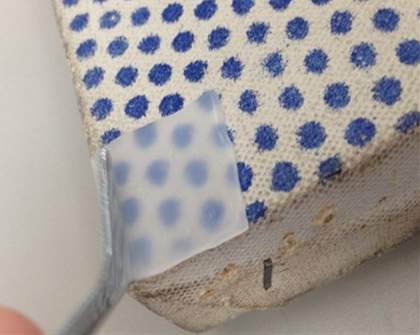
Fig. 1
Peggy 6 gel test in a discrete corner of one of the panels, in an area of ultramarine blue oil Ben-Day dots. The transparent quality of the gel is evident, which allowed us to clearly see the blue underneath. Photo © Tate
The Peggy 6 gel loaded with a TAC solution consistently proved to be the most effective cleaning system for all of the different Whaam! surfaces (i.e. yellow, red and black Magna passages, white alkyd priming and areas with oil Ben-Day dots), although slightly better results were obtained on the alkyd priming areas with a Peggy 6 gel loaded with a micellar solution of ECOSURF™ EH6. The application of gels loaded with surfactant solutions on the Magna paint proved less satisfactory, causing subtle changes in surface gloss. Based on these results, initial plans were made to clean the painting using Peggy 6 gels loaded with two different cleaning materials: a solution of TAC for the areas painted with Magna and for the red/blue and blue Ben Day dots, and a micellar solution of ECOSURF™ EH6 for the exposed white alkyd priming areas.
To avoid the possibility of tidelines being formed when applying successive rectangular 12 x 15 cm Peggy 6 gel sheets (fig.2), the gels were initially cut down to match compositional shapes of the painting, i.e. a flame or a letter. However, this was soon replaced by an application technique where the gels were used as supplied through a cut out Mylar sheet, which masked off the areas we did not want in contact with the gel (fig.3). Further testing was carried out using Peggy 6 loaded with TAC (at concentrations in the range of 0.5-2 % w/w) on the white alkyd priming, exploring exposure times of up to 2 minutes, followed by the equivalent hydrogel clearance step. This approach successfully enabled us to optimise the cleaning process across the range of paint types and hence negated the need for surfactants.
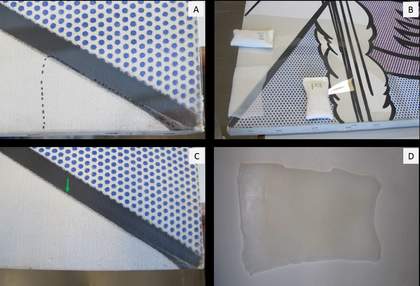
Fig. 2
These images show the initial approach to applying the Peggy 6 gels on Whaam!.
(A) The area to be cleaned was marked out on a Mylar sheet, then cut out.
(B) The gel was then placed in contact with the exposed portion of the painting and left in place for the allocated exposure time, followed by a clearance step (for the same exposure time).
(C) It shows the final results; the green arrow shows the vertical divide between cleaned (left) and uncleaned (right) areas.
(D) It shows the gel after use; note that the exposed area is stained where the soil has been lifted up into its structure.
Photo © Tate
We once again used our combined evaluation methodology to assess the painting surface and hence were able to compare before and after cleaning images of areas of the painting surface. In fig.3, the after-cleaning images reveal a reduction in the black particulates present in the soiling and a distinct reduction in the yellow hue of the surface, which also originated from the soiling layer.
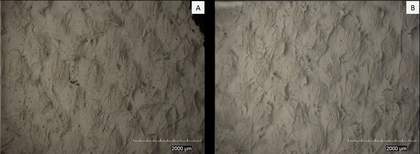
Fig. 3
Representative 2D Hirox images for uncleaned (image A) and cleaned (image B) white alkyd priming. Some black particulates are visible on the uncleaned surface, which was reduced, along with a visible reduction in the yellow cast of the surface, with the cleaning treatment. N.B. Images were not captured in the same location before-after cleaning. Photo © Tate
After the extended period of supporting research and explorations into the properties of the Peggy 6 gel, in early September 2017, we placed our order for a number of gels with CSGI. To clean the entire painting surface (approximately 8 m2), including the tacking edges, we estimated we would need around 100 gels. Prior to their arrival, we performed additional pre-treatment assessments such as acquiring gloss (fig.4) and colour measurements across different areas of each panel, which were repeated again after cleaning.
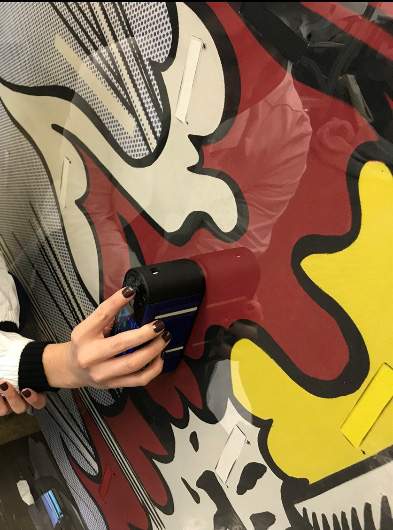
Fig. 4
Gloss meter in use on the right-hand panel. Measuring sites were marked out on a Mylar template in order to repeat measurements in the same exact location after treatment. Photo © Tate
In October 2017, Painting Conservator Rachel Barker commenced the treatment of the painting supported by Angelica, who prepared and looked after the gels, which was completed by early January 2018. The cleaning treatment was followed by minimal retouching, post-treatment assessments (i.e. gloss and colour measurements) and after-treatment photography (fig. 5). The post-treatment assessments demonstrated that there were no detrimental changes to the paint surfaces, that the gloss change resulting from the cleaning treatment was minimal and that the colours, lines, subtle brushwork and gloss variations inherent the painting were now more vibrant and evident, providing a more direct experience than has been possible for many years.
This treatment, which was funded by the project NANORESTART and Tate, is the focus of the Tate Shots film, Conserving Whaam!. This painting is on display at Tate Liverpool as part of the Artist Room: Lichtenstein in Focus exhibition until 17 June 2018.
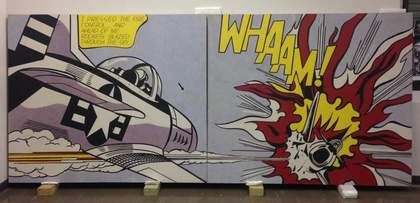
Fig. 5
Whaam! during cleaning. The left hand panel has been cleaned, apart from the area marked with the small black arrow. When comparing the two panels, the left hand, cleaned panel is brighter and less yellowed than the right hand panel. Photo © Tate
Angelica Bartoletti, Rachel Barker, Bronwyn Ormsby
April 2018
